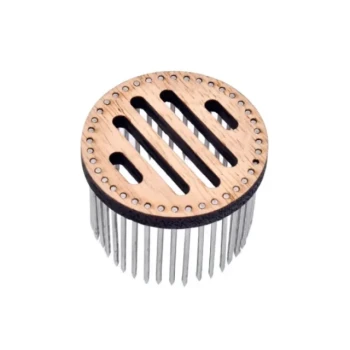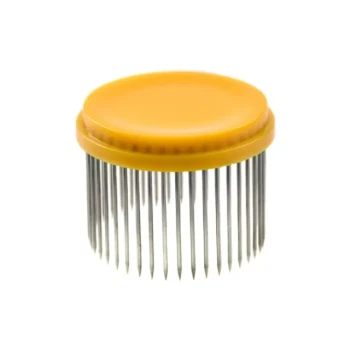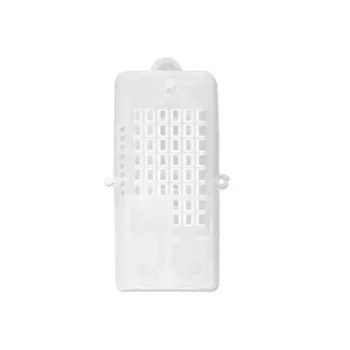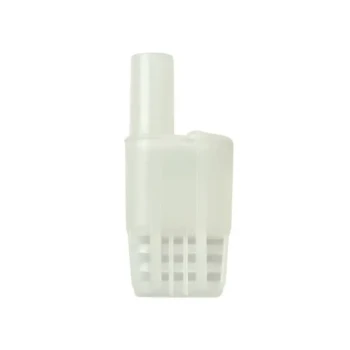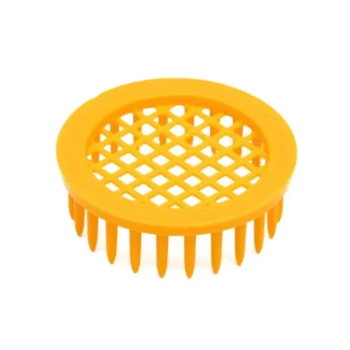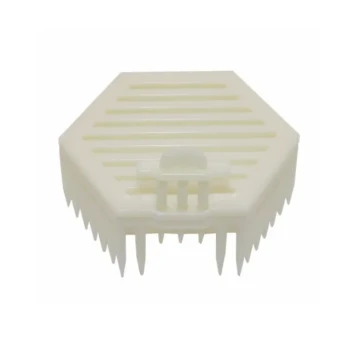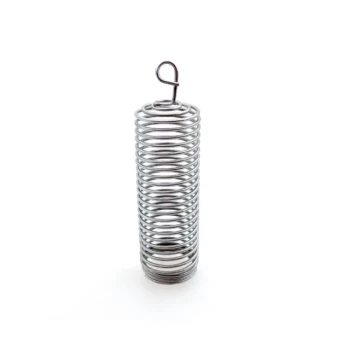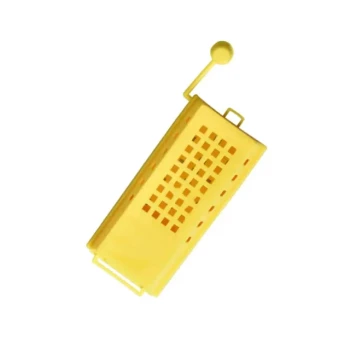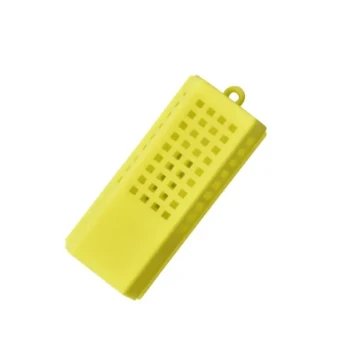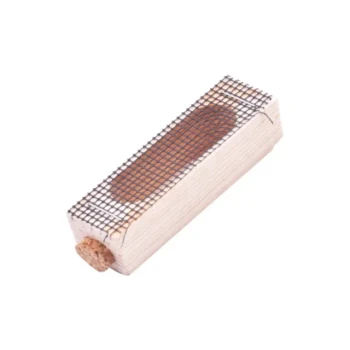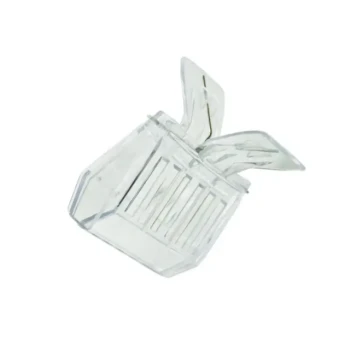In beekeeping, a round press-in cage is a specialized tool designed to safely immobilize a queen bee directly on the surface of the comb. Its purpose is to hold her gently in place without having to pick her up, allowing the beekeeper to apply a mark to her thorax and let it dry before she is released back among the other bees.
The core decision in queen marking is not just which tool to use, but which method minimizes stress for both the queen and the beekeeper. The press-in cage is designed for beekeepers who prioritize keeping the queen on the comb and handling her as little as possible.
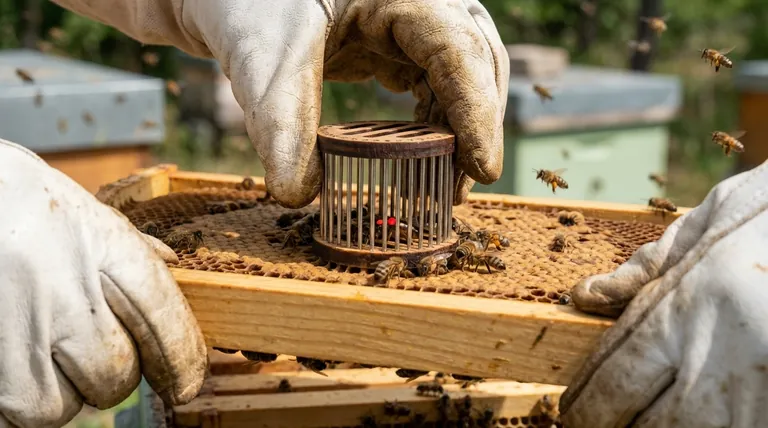
Why We Mark a Queen Bee
Marking the queen is a fundamental practice in modern beekeeping for several critical reasons. It transforms an anonymous colony leader into a known individual.
Instant Identification
A marked queen can be located in seconds among tens of thousands of other bees. This drastically reduces inspection time and the associated disruption to the hive.
Age and Performance Tracking
Beekeepers use an international color code that changes each year. This allows you to know the queen's age at a glance, which is a key factor in evaluating her egg-laying performance and deciding when she may need to be replaced.
Verifying a Queenright Hive
Seeing a marked queen (or her freshly laid eggs) instantly confirms the colony is "queenright" and healthy. If she is missing, you know immediately that you need to take action.
Using a Round Press-in Cage: The On-Comb Method
The press-in cage is favored for its gentle, low-stress approach. The entire marking process happens on the frame, within the queen's natural environment.
The Tool's Design
This cage is a simple, open-bottomed cylinder or square with small metal or plastic prongs along the edge. The top is a mesh or screen that allows you to see the queen and apply paint through it.
The Marking Process
First, you must locate the queen on a frame. Once found, gently place the press-in cage over her, ensuring you do not trap any of her legs.
With the queen centered underneath the mesh, lightly press the cage downwards. The prongs will sink a short distance into the wax of the comb, securing the cage and preventing the queen from escaping.
You can then apply a small dot of queen-marking paint to her thorax (the middle section of her body). Wait a minute for the paint to dry before carefully lifting the cage to release her.
The Primary Advantage
The key benefit is that you never have to pick up the queen. She remains on the comb, surrounded by her attendants. As the references note, this makes for an extremely calm release, reducing the shock and risk of injury associated with handling.
Understanding the Trade-offs and Alternatives
While the press-in cage is an excellent tool, it is not the only option, and its effectiveness depends on the situation.
The Challenge of the Press-in Cage
This method works best on flat, even comb, typically with newly drawn wax or worker brood. It can be difficult to get a good "seal" if you try to press it into uneven comb, honey cells, or drone brood.
The Alternative: Handheld Plunger Cages
A different tool, often confused with the press-in cage, is the handheld plunger cage. With this method, you must first pick up the queen (by her wings or thorax) and place her into a small cylinder.
A foam-tipped plunger is then used to gently push her up against the top mesh, immobilizing her for marking. This gives you complete control but requires the confidence to catch and handle the queen directly.
Comparing the Two Methods
The press-in cage is ideal for minimizing direct contact and stress on the queen. It is often preferred by beekeepers who are less confident in picking up a queen.
The handheld plunger cage offers more control over the queen's position but introduces the stress of being caught and removed from the comb. It is often faster for experienced beekeepers.
Making the Right Choice for Your Goal
Selecting a marking tool depends on your skill, confidence, and the specific conditions in the hive.
- If your primary focus is minimizing direct handling of the queen: The round press-in cage is the superior choice, as it keeps her on the comb in her natural environment.
- If you are confident handling the queen and need to mark her on uneven comb: A handheld plunger cage offers more versatility and control once you have secured her.
- If you are a beginner learning the process: Practice your technique on several drones first, as they are expendable and will help you build the steady hand required for either method.
Ultimately, the best tool is the one that allows you to mark your queen calmly, safely, and successfully.
Summary Table:
| Tool | Primary Use | Key Advantage | Best For |
|---|---|---|---|
| Round Press-in Cage | Immobilizing the queen on the comb for marking. | Minimizes direct handling and stress. | Beekeepers prioritizing gentle, on-comb methods. |
| Handheld Plunger Cage | Marking the queen after picking her up. | Offers more control over queen positioning. | Experienced beekeepers comfortable with handling. |
Equip Your Apiary for Success with the Right Tools
Marking your queens is essential for efficient hive management. Using the right equipment, like a round press-in cage, ensures the process is safe for your queen and stress-free for you.
HONESTBEE supplies beekeepers and beekeeping equipment distributors with the high-quality, durable tools needed for professional apiary management. From marking cages to essential hive equipment, our wholesale-focused operations provide the reliable supplies your business depends on.
Ready to enhance your beekeeping operations with professional-grade equipment?
Contact HONESTBEE today to discuss your needs and discover how our products can support the health of your hives and the success of your business.
Visual Guide
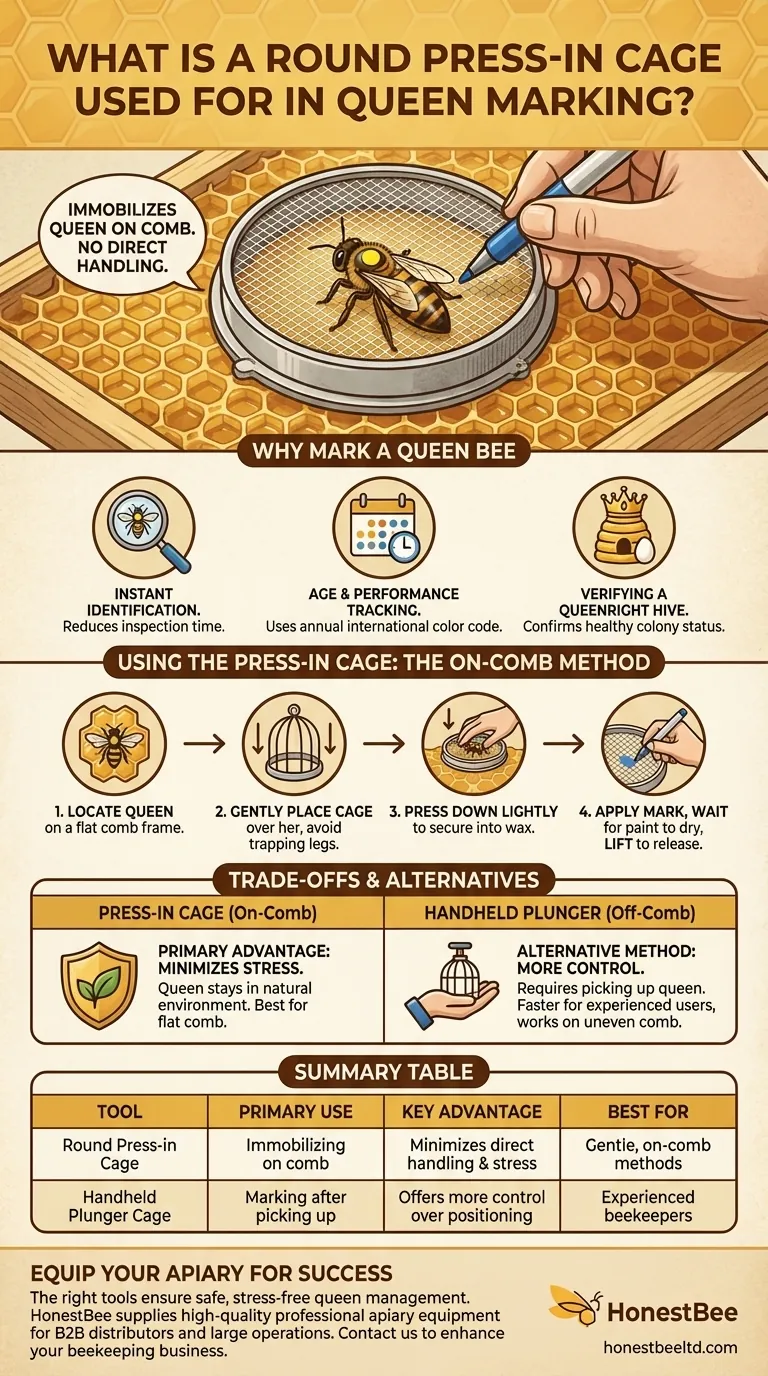
Related Products
- Premium Wood and Steel Push In Queen Cage
- Professional Round Push-In Queen Cage with Metal Tines
- Professional Multi-Functional Queen Bee Cage
- Wood and Mesh Push-In Queen Cage
- Multi-Function Queen Roller Cage and Catcher
People Also Ask
- What are the steps to introduce a queen using a push-in cage? Ensure High Success for Your Valuable Queens
- What is a push-in queen cage and how does it differ from standard cages? Achieve Higher Queen Acceptance Rates
- Where should the queen bee's cage be placed in the hive? Maximize Acceptance in the Brood Nest
- How does a push-in cage improve queen introduction success? Boost Acceptance with Active Queen Demonstration
- How does a press-in cage work for marking a queen bee? A Safer, Simpler Method for Beekeepers
